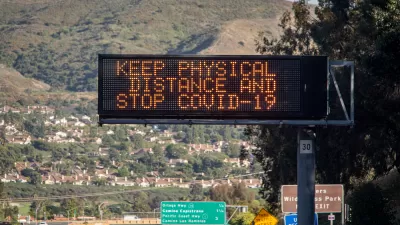The Inland Empire—suburban and exurban counties located to the east of Los Angeles—experienced some of the worst impacts of the housing crisis and recession. Yet, people still arrived there in droves during the recession.
Given the common tales of foreclosure-ridden housing tracts and some of California’s worst unemployment rates, the Inland Empire managed to draw more new residents away from Los Angeles County during the recession than the other way around, reports Emily Alpert Reyes. In fact, new Census Bureau estimates reveal the net migration to be “the nation's biggest net county-to-county movement from 2007 to 2011.”
Although the rate of migration slowed during the recession period from earlier years, the trends were consistent across a broad swath of demographics and occurred despite poor economic conditions in the Inland Empire: “Roughly 35,000 more people poured into the Inland Empire from Los Angeles County than moved in the opposite direction. The migration occurred even as Riverside and San Bernardino counties lost some 144,000 jobs. The people who moved included rich and poor and Angelenos across educational levels, according to the newly released Census Bureau estimates.”
The article includes testimonies from experts who claim that cheap housing accounts for the persistent allure of the Inland Empire.
FULL STORY: Tens of thousands leave Los Angeles County for Inland Empire

Study: Maui’s Plan to Convert Vacation Rentals to Long-Term Housing Could Cause Nearly $1 Billion Economic Loss
The plan would reduce visitor accommodation by 25,% resulting in 1,900 jobs lost.

North Texas Transit Leaders Tout Benefits of TOD for Growing Region
At a summit focused on transit-oriented development, policymakers discussed how North Texas’ expanded light rail system can serve as a tool for economic growth.

Why Should We Subsidize Public Transportation?
Many public transit agencies face financial stress due to rising costs, declining fare revenue, and declining subsidies. Transit advocates must provide a strong business case for increasing public transit funding.

How to Make US Trains Faster
Changes to boarding platforms and a switch to electric trains could improve U.S. passenger rail service without the added cost of high-speed rail.

Columbia’s Revitalized ‘Loop’ Is a Hub for Local Entrepreneurs
A focus on small businesses is helping a commercial corridor in Columbia, Missouri thrive.

Invasive Insect Threatens Minnesota’s Ash Forests
The Emerald Ash Borer is a rapidly spreading invasive pest threatening Minnesota’s ash trees, and homeowners are encouraged to plant diverse replacement species, avoid moving ash firewood, and monitor for signs of infestation.
Urban Design for Planners 1: Software Tools
This six-course series explores essential urban design concepts using open source software and equips planners with the tools they need to participate fully in the urban design process.
Planning for Universal Design
Learn the tools for implementing Universal Design in planning regulations.
City of Santa Clarita
Ascent Environmental
Institute for Housing and Urban Development Studies (IHS)
City of Grandview
Harvard GSD Executive Education
Toledo-Lucas County Plan Commissions
Salt Lake City
NYU Wagner Graduate School of Public Service





























